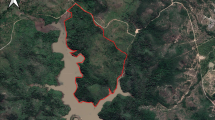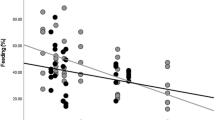Abstract
In this study, I revise three aspects of the socioecology of woolly monkeys (genus Lagothrix) that might give us a better understanding of the patterns found in this species: (1) the association between temporal variation in fruit abundance and diet, activity, and ranging patterns; (2) the individual trade-offs associated with living in small or large groups, and (3) the relationship between social dominance and foraging success. Using behavioral and ecological data collected during 3 years in Tinigua Park, Colombia, I found that woolly monkeys tend to avoid open-degraded forests, where fruit production is generally lower than it is in mature forests. Diet and activity budgets were highly associated with temporal patterns of fruit production. Daily path length was positively correlated with group size and monthly fruit abundance, and negatively correlated with habitat quality. I found differences in activity budgets and the diet preferences of different age/sex classes. For example, adult males rest more and juveniles play more than other classes. Juveniles and adult females without infants look for arthropods more often than adult males and females with young infants, who showed the highest frequencies of fruit feeding. Dominant adult males were not consistently the most efficient foragers on fruits according to two different indexes. Most of these results are consistent with the expectations from strong intra-group competition for resources. However, females with infants received benefits during feeding similar to those of dominant adult males, which may be mediated by differential aggression from males to other group members (juveniles and females without infants).





Similar content being viewed by others
References
Boinski S, Garber PA (2000) On the move: How and why animals travel in groups. University of Chicago Press, Chicago
Buchan JC, Alberts SC, Silo JB, Altmann J (2003) True paternal care in a multi-male primate society. Nature 425:179–181
Chapman AC (1988) Patterns of foraging and range use by three species of Neotropical primates. Primates 29:177–194
Defler TR (1987) Ranging and the use of space in a group of woolly monkeys (Lagothrix lagotricha) in the Nw Amazon of Colombia. Int J Primatol 8:420–420
Defler TR, Defler SB (1996) Diet of a group of Lagothrix lagothricha lagothricha in Southeastern Colombia. Int J Primatol 17:161–189
Dew L (2001) Synecology and seed dispersal in woolly monkeys (Lagothrix lagotricha poeppigii) and spider monkeys (Ateles belzebuth belzebuth) in Parque Nacional Yasuni, Ecuador. PhD dissertation, University of California, Davis
Di Fiore A (2003) Ranging behavior and foraging ecology of lowland woolly monkeys (Lagothrix lagotricha poeppigii) in Yasuni National Park, Ecuador. Am J Primatol 59:47–66
Di Fiore A (2004) Diet and feeding ecology of woolly monkeys in a western Amazonian rain forest. Int J Primatol 25:767–801
Di Fiore A, Rodman PS (2001) Time allocation patterns of lowland woolly monkeys (Lagothrix lagotricha poeppigii) in a neotropical terra firma forest. Int J Primatol 22:449–480
Escobar-Paramo P (1999) Inbreeding avoidance and the evolution of mating strategies. PhD dissertation, State University of New York at Stony Brook, New York
Fooden J (1963) A revision of the woolly monkeys (Genus Lagothrix). J Mamm 44:213–247
Ford SM, Davis LC (1992) Systematics and body size: Implications for feeding adaptations in New World monkeys. Am J Phys Anthropol 88:415–468
Izawa K (1975) Foods and feeding behavior of monkeys in the upper Amazon basin. Primates 16:295–316
Janson CH (1988) Intraspecific food competition and primate social-structure—a synthesis. Behaviour 105:1–17
Janson CH, Goldsmith ML (1995) Predicting group-size in primates—foraging costs and predation risks. Behav Ecol 6:326–336
Janson CH (1992) Evolutionary ecology of primate social structure. In: Smith EA, Winterhalder B (eds) Evolutionary ecology and human behavior. Aldine, New York, pp 95–130
Milton K (1984) The role of food processing factors in primate food choice. In: Rodman PS, Cant JGH (eds) Adaptations for foraging in non-human primates: contributions to an organismal biology of prosimians, monkeys and apes. Columbia University Press, New York, pp 249–279
Milton K, Nessimian JL (1984). Evidence for insectivory in two primate species (Callicebus torquatus lugens and Lagothrix lagothricha lagothricha) from Northwestern Amazonia. Am J Primatol 6:367–371
Nishimura A (1994) Social interaction patterns of woolly monkeys (Lagothrix lagotricha): A comparison among Atelines. Sci Eng Rev Doshisha Univ 35:235–254
Nishimura A (2003) Reproductive parameters of wild female Lagothrix lagotricha. Int J Primatol 24:707–722
Peres CA (1994a) Which are the largest new World monkeys? J Hum Evol 26:245–249
Peres CA (1994b) Diet and feeding ecology of gray woolly monkeys (Lagothrix lagothricha cana) in Central Amazonia: comparisons with other Atelines. Int J Primatol 15:333–372
Peres CA (1996) Use of space, spatial group structure, and foraging group size of gray woolly monkeys (Lagothrix lagotricha cana) at Urucu, Brazil. A review of the Atelinae. In: Norconk MA, Garber PA, Rosemberger AF (eds) Adaptive radiations of neotropical primates. Plenum Press, New York, pp 467–488
Rosenberger AL, Strier KB (1989) Adaptive radiation of the ateline primates. J Hum Evol 18:717–750
van Schaik CA (1989) The ecology of social relationships amongst female primates. In: Standen V, Foleyoelds RA (eds) Comparative socioecology. Blackwell, Oxford, pp 195–218
Soini P (1986) A synecological study of a primate community in the Pacaya Samiria National Reserve, Peru. Primate Conserv 7:63–71
Stevenson PR (1992) Diet of woolly monkeys (Lagothrix lagotricha) at La Macarena, Colombia. Field Stud New World Monk Macarena Colomb 6:3–14
Stevenson PR (1997) Notes on the mating behavior of woolly monkeys (Lagothrix lagotricha) at Tinigua National Park, Colombia. Field Stud Fauna Flora Macarena Colomb 10:13–15
Stevenson PR (1998) Proximal spacing between individuals in a group of woolly monkeys (Lagothrix lagotricha) in Tinigua National Park, Colombia. Int J Primatol 19:299–311
Stevenson PR (2000) Seed dispersal by woolly monkeys (Lagothrix lagothricha) at Tinigua National Park, Colombia: Dispersal distance, germination rates, and dispersal quantity. Am J Primatol 50:275–289
Stevenson PR (2001) The relationship between fruit production and primate abundance in Neotropical forests. Biol J Linn Soc 72:161–178
Stevenson PR (2002) Frugivory and seed dispersal by woolly monkeys (Lagothrix lagothricha) at Tinigua Park, Colombia. PhD dissertation, State University of New York at Stony Brook, New York
Stevenson PR (2004a) Fruit choice by woolly monkeys in Tinigua National Park, Colombia. Int J Primatol 25:367–381
Stevenson PR (2004b) Phenological patterns of woody vegetation at Tinigua National Park, Colombia. Caldasia 26(1):125–150
Stevenson PR (2005) Potential keystone plant species for the frugivore community at Tinigua Park, Colombia. In: Dew L, Boubli JP (eds) Tropical fruits and frugivores: the search for strong interactors. Springer, The Netherlands Berlin Heidelberg pp 38–57
Stevenson PR, Castellanos MC (2000) Feeding rates and daily path range of the Colombian woolly monkeys as evidence for between- and within-group competition. Folia Primatol 71:399–408
Stevenson PR, Castellanos MC (2001) New evidence for large variations in daily path length related to differences in habitat quality in troops of Colombian Woolly Monkeys, Lagothrix lagothricha. XVIII Congress of the International Primatological Society, Adelaide, South Australia, pp 446
Stevenson PR, Quiñones MJ, Ahumada JA (1994) Ecological strategies of woolly monkeys (Lagothrix lagotricha) at La Macarena, Colombia. Am J Primatol 32:123–140
Stevenson PR, Quiñones MJ, Ahumada JA (1998) Effects of fruit patch availability on feeding subgroup size and spacing patterns in four primate species at Tinigua National Park, Colombia. Int J Primatol 19:313–324
Stevenson PR, Quiñones MJ, Ahumada JA (2000) Influence of fruit availability on ecological overlap among four neotropical primates at Tinigua National Park, Colombia. Biotropica 32:533–544
Strier KB (1992) Atelinae adaptations—behavioral strategies and ecological constraints. Am J Phys Anthropol 88:515–524
Strier KB, Mendes FDC, Rimoli J, Rimoli AO (1993) Demography and social-structure of one group of muriquis (Brachyteles arachnoides). Int J Primatol 14:513–526
Symington MM (1988) Demography, ranging patterns, and activity budgets of black spider monkeys (Ateles paniscus chamek) in the Manu-National Park, Peru. Am J Primatol 15:45–67
Terborgh JW, Janson CH (1986) The socioecology of primate groups. Annu Rev Ecol Syst 17:111–135
Yumoto T, Kimura K, Nishimura A (1999) Estimation of the retention times and distances of seed dispersed by two monkey species, Alouatta seniculus and Lagothrix lagotricha, in a Colombian forest. Ecol Res 14:179–191
Acknowledgements
I would like to thank all the field assistants who helped in gathering information, especially Maria Clara Castellanos, Alicia Medina, Carolina García, Monica Pineda, and Tatiana Samper. I thank Charles Janson, Patricia Wright, John G. Fleagle, Anthony DiFiore, Akisato Nishimura, Nicole Gibson, and an anonymous referee for their comments. This study was possible thanks to logistic support of CIEM (Centro de Investigaciones Ecológicas La Macarena) and the permits from Unidad de Parques Nacionales. Financial support came from the following institutions: La Fundación para la Promoción de la Investigación y la Tecnología (Banco de la República), Margot Marsh Foundation, Lincoln Park Zoo, Primate Conservation Inc., and IdeaWild.
Author information
Authors and Affiliations
Corresponding author
About this article
Cite this article
Stevenson, P.R. Activity and ranging patterns of Colombian woolly monkeys in north-western Amazonia. Primates 47, 239–247 (2006). https://doi.org/10.1007/s10329-005-0172-6
Received:
Accepted:
Published:
Issue Date:
DOI: https://doi.org/10.1007/s10329-005-0172-6




